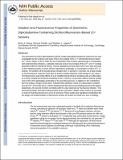Solution and Fluorescence Properties of Symmetric Dipicolylamine-Containing Dichlorofluorescein-Based Zn[superscript 2+] Sensors
Author(s)
Wong, Brian A.; Friedle, Simone; Lippard, Stephen J.
DownloadLippard_Solution and fluorescence.pdf (2.458Mb)
PUBLISHER_POLICY
Publisher Policy
Article is made available in accordance with the publisher's policy and may be subject to US copyright law. Please refer to the publisher's site for terms of use.
Terms of use
Metadata
Show full item recordAbstract
The mechanism by which dipicolylamine (DPA) chelate-appended fluorophores respond to zinc was investigated by the synthesis and study of five new analogues of the 2′,7′-dichlorofluorescein-based Zn[superscript 2+] sensor Zinpyr-1 (ZP1). With the use of absorption and emission spectroscopy in combination with potentiometric titrations, a detailed molecular picture has emerged of the Zn[superscript 2+] and H[superscript +] binding properties of the ZP1 family of sensors. The two separate N[subscript 3]O donor atom sets on ZP1 converge to form binding pockets in which all four heteroatoms participate in coordination to either Zn[superscript 2+] or protons. The position of the pyridyl group nitrogen atom, 2-pyridyl or 4-pyridyl, has a large impact on the fluorescence response of the dyes to protons despite relatively small changes in pK[subscript a] values. The fluorescence quenching effects of such multifunctional electron-donating units are often taken as a whole. Despite the structural complexity of ZP1, however, we provide evidence that the pyridyl arms of the DPA appendages participate in the quenching process, in addition to the contribution from the tertiary nitrogen amine atom. Potentiometric titrations reveal ZP1 dissociation constants (K[subscript d]) for Zn[superscript 2+] of 0.04 pM and 1.2 nM for binding to the first and second binding pockets of the ligand, respectively, the second of which correlates with the value observed by fluorescence titration. This result demonstrates that both binding pockets of this symmetric, ditopic sensor need to be occupied in order for full fluorescence turn-on to be achieved. These results have significant implications for the design and implementation of fluorescent sensors for studies of mobile zinc ions in biology.
Date issued
2009-04Department
Massachusetts Institute of Technology. Department of ChemistryJournal
Journal of the American Chemical Society
Citation
Wong, Brian A., Simone Friedle, and Stephen J. Lippard. “Solution and Fluorescence Properties of Symmetric Dipicolylamine-Containing Dichlorofluorescein-Based Zn2+ Sensors.” Journal of the American Chemical Society 131, no. 20 (May 27, 2009): 7142-7152.
Version: Author's final manuscript
ISSN
0002-7863
1520-5126